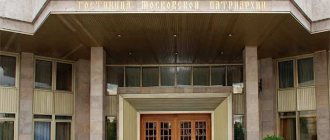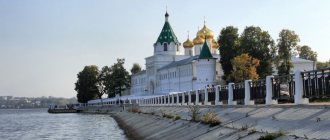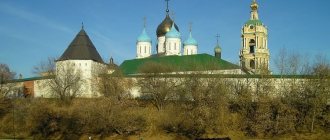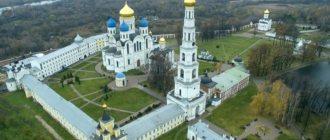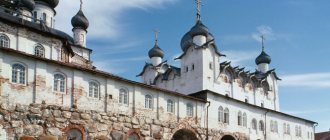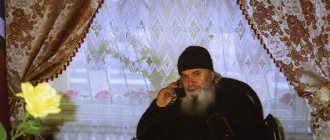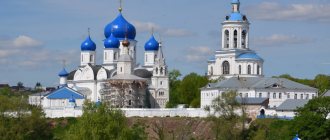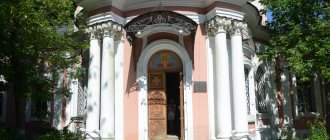Yaroslavl Tolgsky Convent – an amazing and unusual place. At one time, it became the first convent in Russia, restored during the Soviet Union. Many valuable shrines are kept here, its architecture is fascinating, and the history of the creation of the monastery - as well as the many miracles that took place here during its existence - suggest that this is truly a Place of Power. If you want to learn more about the sights and shrines of the Holy Vvedensky Tolga Convent in Yaroslavl, my story will help you with this.
How to get there (from Moscow, Yaroslavl)?
- Using railway transport. From Moscow from the Yaroslavsky station (located near the Komsomolskaya metro station) trains go daily towards Yaroslavl: No. 104Ya, 102Ya, 230Ya, 264Ya, 016M, 376Ya, 080M, 070Ch, 224Ch, 034Ya, 208Z, 248Ya.
From the railway station in Yaroslavl you can take minibus No. 93G and take it to the stop. "st. Zheleznodorozhnaya village Tolgobol." Or you can take trolleybus No. 1, get to the stop. "Red Square", here change to bus No. 21, 34, 21k or minibus No. 93 and get to the stop. "st. Zheleznodorozhnaya village Tolgobol." From here you just have to walk 2 km to the monastery gate. Did you know? Also in the summer, from the railway station in Yaroslavl you can take trolleybus No. 1 to the stop. "Red Square", where the River Station is located. From here, take a boat that will take you to the monastery. - By bus. Not far from the station. m. "Shchelkovskaya" is the central Moscow bus station. Buses depart from it daily to Yaroslavl (the first one is at 8:30, the last one is at 23:15). Further in Yaroslavl from the bus stop. “Red Square” by bus number 34 you can get almost to the monastery (you just have to walk a little).
- By your car. If you own your own vehicle, you can get to the monastery from Moscow via the Yaroslavskoe highway and the Kholmogory highway (M8).
Features of visiting the monastery
The Tolga Monastery in Yaroslavl is open from early morning until late evening, its opening hours for visitors are from 5:00 to 23:00.
Did you know? During the day, prayers are read, services and sacraments are performed in the monastery churches. Most of the monastery shrines are open to free visits.
If you wish, you can
book a tour of the monastery territory, as well as agree on requirements.
Important! Remember that on the territory of the monastery and especially in its churches and near shrines, strict rules must be observed. If you violate them, you may be asked to leave the monastery territory.
Miracle healings
The most famous miracle of healing happened to the first crowned Tsar of All Rus', Ivan the Terrible. Being bedridden with severe joint pain, he asked to be taken to the shrine. John prayed in front of her for several days, until he finally left the monastery on his own feet.
Since then, the holy face has never ceased to amaze Orthodox Christians with its healing power. So, in 1995, prayers to the Mother of God helped a 14-year-old boy get rid of a hump and the serious consequences of a spinal fracture. At the same time, another boy forever threw away the crutches, without which he could not walk.
In the 21st century, miracles of healing continued. After the mother’s long prayers for her son, he was cured of a heart disease over which modern medicine was powerless. A few years later, another miracle happened - the girl’s warts, which were planned to be removed surgically, disappeared on their own. Two years later, a parishioner who had been addicted for a long time was cured of alcoholism.
The official date for the celebration of the Mother of God image is August 21
Schedule of services at the Tolga Monastery
- On weekdays, morning services begin at 6:00, and if there was a simple service the day before, then at 5:30.
- The morning service includes: morning prayers, midnight office and Akathist.
- Then at 7:00 the Divine Liturgy is read.
- Evening services begin at 16:00 (an hour later in the summer).
- On Sundays, morning prayers, midnight office and akathist are read at 7:00.
- At 8:00 the Divine Liturgy is held.
- Evening services begin at 16:00 (in summer at 17:00), as on weekdays.
- Confession is performed every day after the Midnight Office.
Prayer before the face of the Mother of God
O Most Holy Lady, Virgin Mother of God, above the Cherubim and Seraphim and the holiest of all saints! You, the All-Blessed One, on Tolga, You deigned to reveal Your multi-healing icon to the blessed Saint Tryphon in a fiery way, and with it You performed many and ineffable miracles, and are now doing them, according to Your ineffable mercy towards us. Before Your most pure image we bow down and pray, O Most Blessed Intercessor of our race: in this much-sorrowful and much-rebellious earthly journey, do not deprive us of Your intercession and the protection of God.
Save and protect us, Lady, from the fiery arrows of the evil enemy of our salvation. Strengthen our weak will to do the commandments of Christ, soften our hardened hearts with love for God and our neighbors, grant us heartfelt contrition and true repentance, so that, having been cleansed from the filth of sin, we will be able to bring to the Creator the fruits of good deeds pleasing to Him and we will be honored with a peaceful Christian death and response right at His terrible and impartial Judgment. Hey, Lady All-Merciful!
In the hour of menacing death, show us Your powerful intercession, then hasten to help us, helpless, and with Your sovereign hand free us from the power of the fierce world ruler, for truly Your prayer can do a lot before the face of the Lord, and nothing will stop Your intercession, only admiration . Also, looking tenderly at Your holy image and before it, as if You are alive and living with us, we worship, with good hope, ourselves, and each other, and our whole life to You, according to God, we prayerfully commend to You and we magnify You with our Savior born of You, The Lord Jesus Christ, to Him, with His Father Without Beginning and the Most Holy Spirit, is due all glory, honor and worship, now and ever and unto ages of ages. Amen.
The power of prayer truly works wonders. The Ever-Virgin, being the Intercessor of all Christians before God, always responds to calls for help. She, like a real Mother, never leaves Her children in trouble, showing another miracle of Divine grace.
If you find an error, please select a piece of text and press Ctrl+Enter.
Where can you stay near the monastery?
There are pilgrim buildings on the territory of the monastery, where visitors can stay in cozy 1-2-3-5-7-9-12-bed rooms.
Important! Accommodation and meals are subject to a negotiated fee and are only possible for pilgrims (not tourists). To settle in the pilgrimage corps, you must have a passport with you.
Did you know? If you wish, you can perform useful obediences for the monastery and live here for free.
Tourists who are not pilgrims can stay in one of the hotels in Yaroslavl.
History of the Tolga Monastery
- The monastery was founded in 1314 as a monastery by the Rostov Bishop Prokhor under amazing circumstances.
Did you know? The bishop was returning home from a long trip and stopped to spend the night near Yaroslavl. Suddenly he saw a heavenly glow on the other side of the Volga. A bridge appeared out of nowhere over the river. Having crossed it and finding himself on the other side, the bishop saw the Image of the Mother of God. He prayed all night, and the next morning he found a miraculous icon in this place. - On the same day, a small wooden chapel was built here, where the icon was placed. Then a wooden church was erected on this site, and later other monastery buildings, stone churches and fortress walls.
- The Tolgsky monastery repelled more than one attack and suffered more than once from fire.
- With the advent of Soviet power, the monastery was closed, but it was one of the first restored in Soviet times.
- The monastery was returned to the church in 1987 , but as a women's monastery.
Superiors, prioresses
- Herman (mentioned 1392)
- Cassian (mentioned February 2, 1541)
- Jonah (mentioned 1555 and 1556)
- John (mentioned December 1, 1561)
- St. Theodosius (Kharitonov) (1578 - 1602)
- Jonah II (1606 - 1611)
- Macarius (mentioned 1613, 1614)
- Serapion (1618 - October 5, 1634)
- Adrian (1635 - 1640)
- Joel (1641 - 1650)
- Misail I (mentioned 1652, 1654)
- Filaret (mentioned 1655, 1656)
- Misail II (mentioned 1659, 1660, 1661)
- Dionysius (mentioned 1662)
- Misail III (mentioned July 28, 1663)
- Sergius (1662 - 1666)
- Savvaty (1666 - 1671)
- Gordian (1671 - 1700)
- Filaret I (1701 - 1705)
- Cornelius (mentioned 1707)
- Rafail (Kazanovich) (mentioned December 25, 1707)
- Jonah I (1711 - 1719)
- Daniel (1719 - 1722)
- Athanasius (Paussius-Kondoidi) (March 2, 1722 - July 8, 1723)
- Filaret II (mentioned in January 1724)
- Pimen (Savelov) (1729 - 1736)
- Raphael II (1736 - 1737)
- Joseph I (1737 - 1743)
- Ioannikiy (1743 - 1746)
- Gabriel I (1746 - 1747)
- Joseph II (1747 - 1752)
- Joseph III (1752 - 1754)
- Boniface (Boretsky) (1754 - 1758)
- Parmen (28 April - 3 August 1758)
- Hilarion (Zavalevich) (August 13 - September 10, 1758)
- Cyprian (1758 - 1762)
- Irinarch I (1762 - 1775)
- Filimon (Terletsky) (1775 - 1786)
- John (Terlikov) (1786 - 1789)
- Porfiry (1790 - 1795)
- Anastasy (1795 - 1797)
- Nikon (1797 - 1799)
- Augustine (Sakharov) (1798 - 1800)
- Moses (1800 - 1812)
- John (March 29 - October 16, 1813)
- Apollos (Alekseevsky) (September 29, 1813 - December 18, 1816)
- Theophylact (Protopopov) (1816 - 1820)
- Gabriel (Rozanov) (January 11 - September 18, 1821)
- Aaron (Narcissov) (1821 - 1826)
- Jason (Nikolsky) (March 19, 1826 - 1830)
- Irinarch (Popov) (February 1831 - January 1833)
- Abraham (Shumilin) (September 3, 1836 - April 18, 1844)
- Macarius (1836 - 1838)
- Afanasy (Sokolov) (1838 - 1841)
- Theognost (Lebedev) (1841 - 1848)
- Iriney (Nesterovich) (April 17, 1848 - May 18, 1864)
- Flavian (Ostroumov) (March 20, 1865 - May 24, 1868)
- Vladimir (Milovidov) (July 10, 1868 - 1877)
- Pavel (Glebov) (1877 - December 21, 1891)
- German (Khanov) (1892 - 1897)
- Porfiry (Kulakov) (1897 - April 29, 1910)
- Sschmch. Seraphim (Samoilovich) (June 23, 1910 - 1915)
- Anempodist (Alekseev) (1917 - 1921)
- From 1928 to 1987 the monastery was closed
Sights of the monastery
On the monastery territory there are two main churches - the Cathedral of the Entry of the Blessed Virgin Mary into the Temple and the Church of the Exaltation of the Cross. Both buildings date back to the 17th century. These are very beautiful buildings with original architecture and rich festive interior decoration. Paintings from the 17th century have been partially preserved in the Vvedensky Church. Also noteworthy are the ancient and thick fortress walls , which more than once saved the monastery from enemy raids. Other interesting buildings:
- Church of the Savior Not Made by Hands;
- Church of St. Nicholas the Wonderworker;
- Chapel of Tryphon;
- Chapel of the Blessed Virgin Mary;
- Chapel of Alexander Nevsky.
Once in the Tolga Monastery, be sure to take a walk through its dense cedar grove, which began in the 16th century.
Architectural monuments on the monastery territory
The majestic architectural ensemble of the monastery, which was mainly formed at the end of the 17th - beginning of the 18th century, is today considered one of the most beautiful on the Volga.
The oldest of its buildings, the Church of the Exaltation of the Cross with a refectory, was erected in 1625. Church services are held there in the autumn-winter period.
The central place of the monastery is occupied by the Vvedensky Cathedral, built in the early 80s of the 17th century. It is notable for its rich frescoes painted in 1690. Divine services in this temple are held only in the summer.
The Spasskaya Church appeared in the monastery at the very beginning of the 18th century on the site of a dilapidated wooden church. Its construction served as a reminder of the gift of Tsar Ivan the Terrible - the ancient icon of the Savior Not Made by Hands.
In addition, among the old buildings in the monastery, the very beautiful gate St. Nicholas Church (1672) and the chapel, erected at the end of the 19th century in honor of the monks killed in the Time of Troubles, have been preserved.
Shrines of the monastery
The convent in the Yaroslavl region owes its existence to the famous miraculous Tolga icon . It is this that is the main monastery shrine. Many miracles are associated with the icon. Her very appearance was extraordinary, and during her stay in the monastery several more amazing stories happened:
- The icon incredibly survived the fires;
- It streamed myrrh several times;
- Raised a dead child;
- Healed Ivan the Terrible from a leg disease;
- Saved Yaroslavl from drought.
It is to this icon that most pilgrims from all over the world rush. Most of the time she is in the Holy Cross Church. There are many other valuable shrines and church relics in the Tolga Monastery:
- A piece of the Robe of Jesus Christ and the Robe of the Most Holy. Mother of God;
- Relics of St. Ignatius Brianchaninova;
- Relics of the founder Tryphon;
- A piece of the nail with which Jesus Christ was crucified;
- Piece of the Shroud of Turin;
- Piece of the Chiton of John the Baptist;
- Particles of the relics of the twelve apostles, St. Nicholas the Wonderworker, Gregory the Theologian and Spyridon of Trimifunt (along with his shoe), martyr. Barbarians and others;
- Icons with particles of the relics of St. Pitirim of Tambov, Theodosius of Chernigov, martyr. John the Warrior and Nikita, Blessed. matrons of Moscow, etc.
Meaning and Interpretation
The Tolga image of the Mother of God belongs to the Eleus (Tenderness) icon painting type and is often called “Throne” among representatives of the Russian Orthodox Church. The main difference between this icon is its emotionality, which stands out from the usual iconographic canons.
It was not for nothing that the author chose dark tones that prevail in the composition. They favorably emphasize and enhance the sad mood that can be read on the face of the Mother of God. The Most Holy Virgin Mary grieves for humanity, seeing what is happening on earth, but still remains the Heavenly Intercessor before the Lord.
The image of the Divine Couple is imbued with the endless love that exists between the Almighty and man. That is why the Baby Jesus clings to His Mother so childishly, wrapping his thin arms around Her neck. In this composition, the icon painter shows the peace and tranquility that the Savior gives to all who turn to Him.
Photo of the Tolga Monastery in Yaroslavl
The monastery is surrounded by ancient fortress walls.
The main monastery church.
And this is inside it - some of the paintings date back to the 17th century!
The monastery recently celebrated its 700th anniversary!
The famous Tolga icon of the Mother of God.
The cedar grove in the monastery is just beginning to recover after the decline of Soviet times.
